Navigation
Install the app
How to install the app on iOS
Follow along with the video below to see how to install our site as a web app on your home screen.
Note: This feature may not be available in some browsers.
More options
Style variation
-
Congratulations MintJulep on being selected by the Eng-Tips community for having the most helpful posts in the forums last week. Way to Go!
You are using an out of date browser. It may not display this or other websites correctly.
You should upgrade or use an alternative browser.
You should upgrade or use an alternative browser.
Miami Beach, Champlain Towers South apartment building collapse, Part 02 151
- Thread starter dik
- Start date
- Status
- Not open for further replies.
NOLAscience
Structural
Spartan5 said:It’s paraphrased, here:
I'm looking for the original statements, not the paraphrase, which I had already read.
Was the slab around the corner of the jacuzzi in positive or negative bending? Hard to say, isn't it? That's my point...especially since I can't see the opening accounted for on any of the structural drawings. (Landscape drawings, yes, but not the structural ones.) I'm not saying that that caused the collapse but it probably gave the fracture a good path to propagate.
NOLAscience
Structural
AtomixPro said:This is interesting. Video of deck failure visible through the north parking entrance. All prior to the full on building collapse.
I don't use TikTok. Ask him/her when this video was taken and if there is any other video.
I am wondering about the source for the dripping water, among other things.
I disagree that the unzipped rebars do not indicate a defect. While it is normal for rebar to pull out of concrete with enough down force, what is not normal is that there is no concrete adheared to the rebars. I base this on engineering for a demo company for 20 years. Either the concrete was soft or the rebars corroded to the point there was no bond with the concrete.
NOLAscience
Structural
JimmyP80 said:the slab-column joint's are a universal issue
Definitely. Also,
(1) Water and salt and lack of slope of the pool deck may have contributed to that failure.
(2) Adding load to the the column by building a penthouse whose loads may not have been included in the calculations could not have helped.
(3) Standing water in the basement did not help with (1).
(4) Rebar ripping clean implies the potential that concrete in the parking and lobby slabs that did not meet specs. This did not help.
(5) Column "" was in a planter for 40 years, with irrigation and rain and soil.
Let's add to this list. Who has a contribution to be "(6)"?
I agree, GPR guys charge way too much, either due to equipment costs or profit but it's not detailed enough of an image. But this is it, the eyeball is all we have?
Early press mentioned a crane had been on site the day of the collapse, for starting the roof work. I found it strange the guy left site, with no evidence of unloading materials.
Just wondered where you'd park it on the lot, if this was a factor.
Early press mentioned a crane had been on site the day of the collapse, for starting the roof work. I found it strange the guy left site, with no evidence of unloading materials.
Just wondered where you'd park it on the lot, if this was a factor.
-
3
- #209
TikTok frame enhancement and perspective:
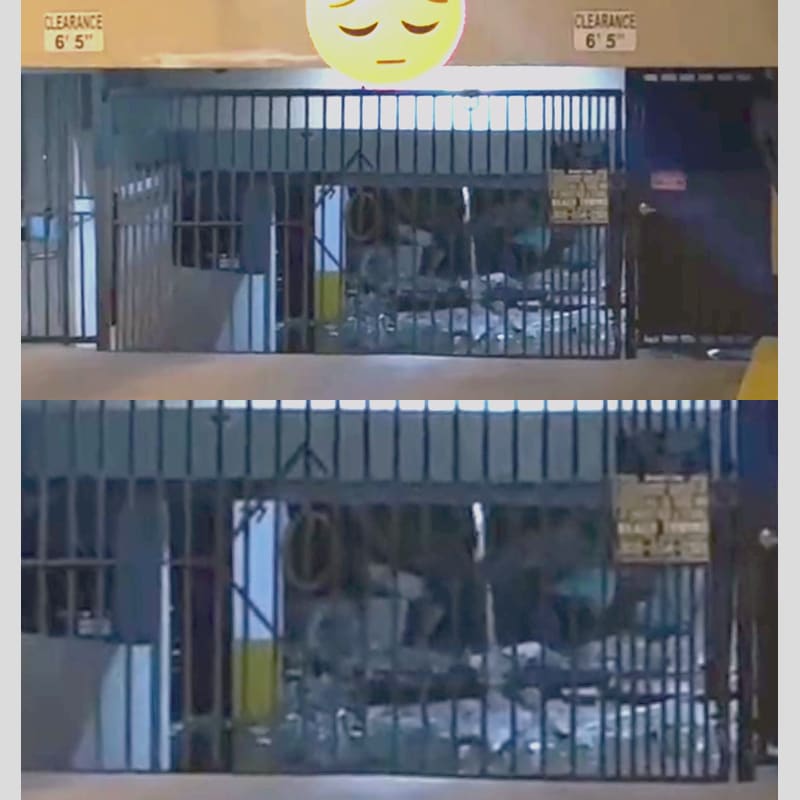
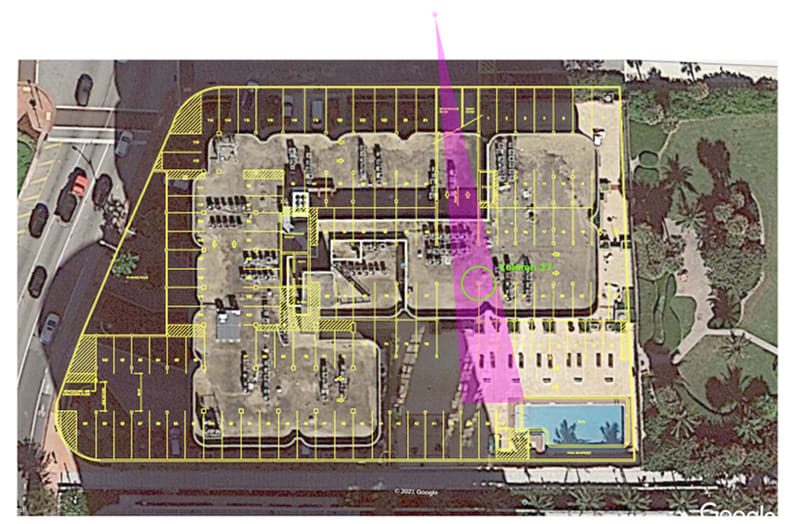
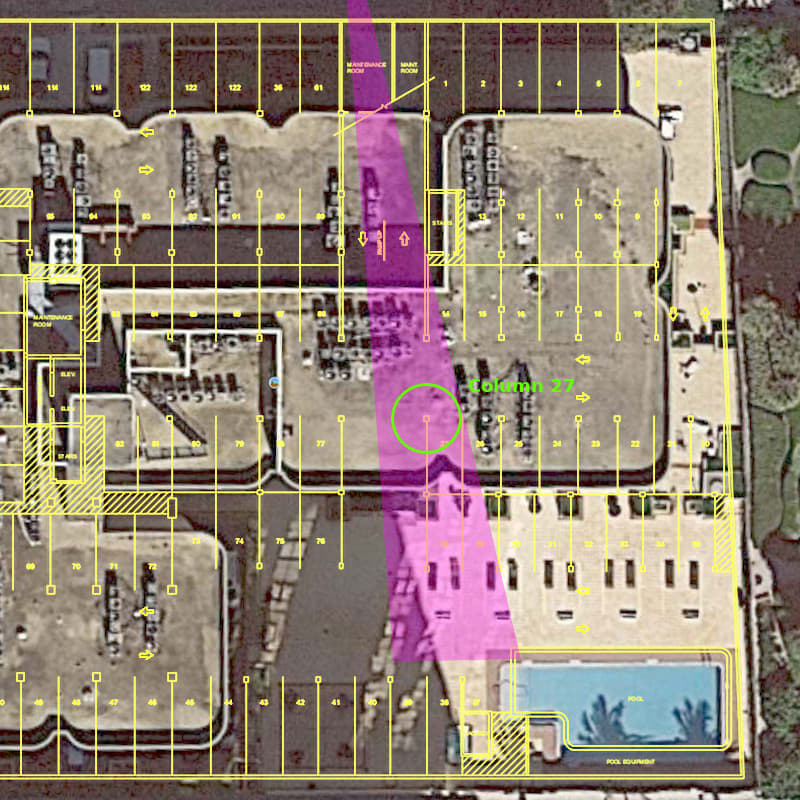
The parallax shifts made these overlays difficult, that is to say that they were a good start but I didn't do a good enough job. Please see my later posts for better alignment where it really matters.



The parallax shifts made these overlays difficult, that is to say that they were a good start but I didn't do a good enough job. Please see my later posts for better alignment where it really matters.
The firms they brought in, Musser Rutledge and KCE are impressive. I have worked with Alan Kilshimer, whom is principle of KCE, and he can take control of a heated meeting like nobody else. Back in 2014 the talk was he billed $600/hr for this type of work.
TheGreenLama
Structural
Sym P. Ie, don't those numbers painted on the columns indicate parking stalls? Number visible looks like 27 (or 77?). Which would place damage further in, or to the west, at time of shot.
NOLAScience said:I don't use TikTok. Ask him/her when this video was taken and if there is any other video.
I am wondering about the source for the dripping water, among other things.
The TikTok video was taken by Adriana Castillero, who was staying in the hotel next door. They were by the pool. You can see on google the hotel pool has a direct view of the North face of the collapsed wing and garage.
Her husband Roberto Castillero was interviewed by the local media. You can see the interview here. He describes seeing a collapse in the garage.
Multiple enlightening interviews of the unit 111 tenant, Sara Nir, have just been released (we've heard from the son the morning of the collapse, but the mom was the one who saw the upper parking deck collapse in real time from the lobby. It's odd how she describes how the noises were coming from above. It seems unlikely given all the known details so far, but who knows.
Highly recommended:
From the drawings, the debris seen in the tiktok video would be either immediately below her unit or just outside her unit in the patio/pool deck. Others here have been trying to sort this out by counting columns but it seems inconclusive thus far? There was no mention of her floor collapsing, which I imagine her son and daughter who stayed behind for a bit would have commented on.
One of the problematic planters and the first failed columns were all near unit 111.
Ironically the other escapee, Maria Monteagudo, was from Unit 611. Above 111. Their proximity to the failure saved them.
TheGreenLama (Structural) 30 Jun 21 20:12 said:don't those numbers painted on the columns indicate parking stalls?
Yes they do and I was perhaps a little hasty in not better identifying the column. A crop of the parkade map from the posted documentation may be more helpful. The frame view is clearly of the northwest corner/column of stall 27.
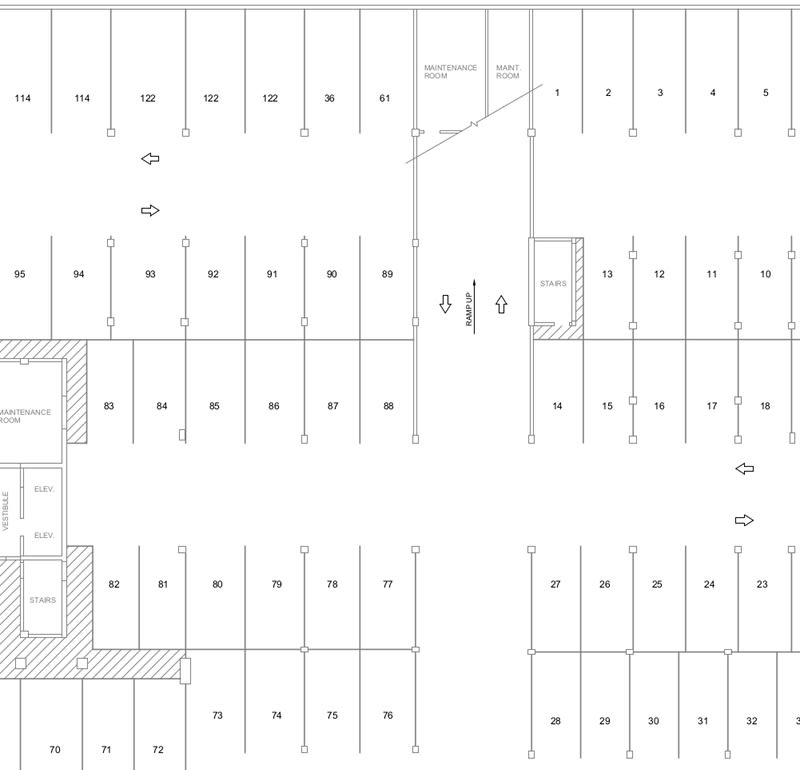
A closer look beyond this column may be the first indication of structural collapse.
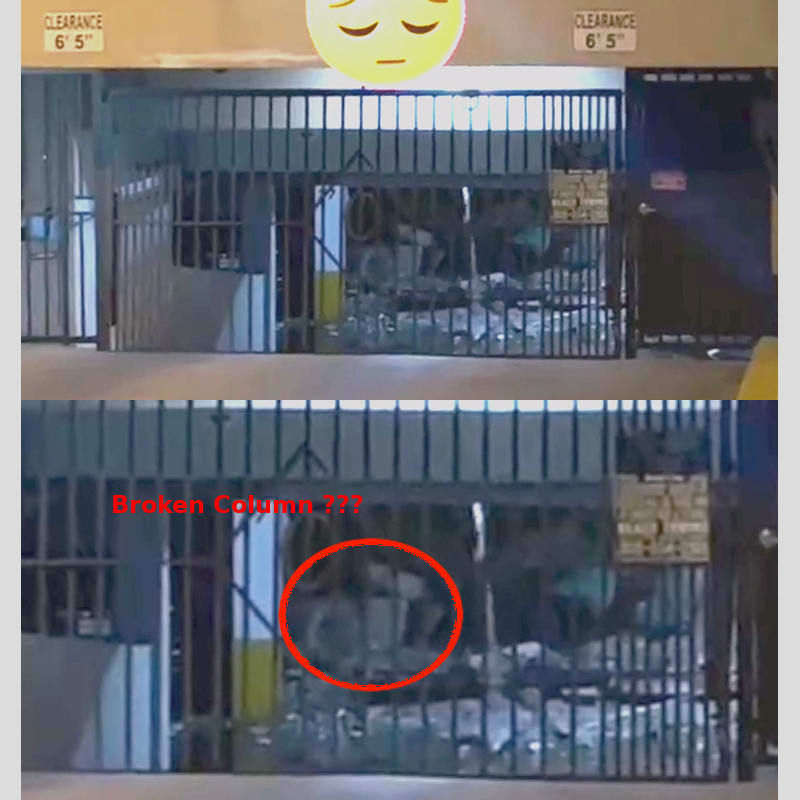
EDIT: Image deleted and replaced with a more accurate overlay in my next post
-
1
- #215
NOLAscience
Structural
warrenslo said:I think the roof work + additional stone/tile/marble within units + HVAC equipment + aging of the building contributed.
jrs87 said:The additional loading of the heavy flooring and countertops can be estimated easily. In the 80's it was all shag and Formica. Many of the balconies had tile added which to me is not ever a good idea.
bradw1128 said:Do we know what the actual design loads were and how they compare with modern-day assumptions?
All - Good points about the weight of materials in 2021 vs 1982 and the uniform live loads, but I don't think it will play out as a significant factor. Even 3 cm granite only weighs 18 psf, and there are large open areas in a kitchen, say, with only tile (typ max 7 psf) flooring and not much else.
One typical code used in 1981 was very similar to the 1982 Uniform Building Code. I used a similar code when I began as an EI in the late 80s, and 40 psf sounds like what we used for residential units.
The Uniform Live Load from Table A23-1 of that code is 40 psf for Residential use,
using these definitions:
"DEAD LOAD is the vertical load due to the weight of all permanent structural
and nonstructural components of a building, such as walls, floors, roofs and fixed
service equipment."
"LIVE LOAD is the load superimposed by the use and occupancy of the
building not including the wind load, earthquake load or dead load."
I would consider flooring (tile), cabinets and countertops, and furniture to all be live loads, then and now, because all can be removed with simple hand tools.
There was a provision for having only dead load in one span and full uniform live load in the two adjacent spans, because this can be a critical loading condition. Live load would be everything other than the structure itself (concrete columns and slabs), in my opinion. I'd even consider plumbing and electrical to be live loads, because they could be removed from one span while being present in the adjacent spans, which could be fully loaded to 40 psf with those items plus flooring, cabinets, countertops, furniture, and people.
The live load reduction was allowed to be:
R=r(A-150) .................... (6-1)
The reduction shall not exceed 40 percent for members receiving load from one
level only, 60 percent for other members, nor R as determined by the following
formula:
R = 23.1 (1 + DIL) ................... (6-2)
127
2306-2308 UNIFORM BUILDING CODE
WHERE:
R = Reduction in percent.
r = Rate of reduction equal to .08 percent for floors. See Table No. 23-C for
roofs.
A Area of floor or roof supported by the member.
D = Dead load per square foot of area supported by the member.
L = Unit live load per square foot of area supported by the member.
For storage live loads exceeding l 00 pounds per square foot, no reduction shall
be made, except that design live loads on columns may be reduced 20 percent.
The live load reduction shall not exceed 40 percent in garages for the storage of
private pleasure cars having a capacity of not more than nine passengers per
vehicle.
Many of the building beams would qualify for taking a LL reduction, but I have not calculated it. You can do the calculations, but (1) we don't know what furniture or other movable items were in each unit last Thursday, and (2) I don't think heavier materials on counters and floors will turn out to exceed the 1980 design loads, even with the applicable LL reductions. One exception would be in rooms used as offices or studies, which might have storage of paper files.
Please reply with your thoughts.
NOLAscience
Structural
smaarch said:the posts in defense of a profession instead of finding the problem
Please be more specific. I see that the vast majority of posts here are directed to studying the problem through evidence such as drawings, photos, and eyewitness testimony. Most contributors are willing to stand corrected when early evidence is refuted by later evidence. I see contributors changing their opinion as they take in new information. For the posts that seem to just jump in, make a statement, and leave -- I mostly ignore them, unless they say something profound by shear luck.
So, again, please point to the contributions that you say are defending the profession instead of finding the problem.
-
1
- #217
NOLAscience
Structural
RE: The upcoming 40 year recertification
Could the anticipated 40 year recertification have CONTRIBUTED to the board's inaction in 2018? I can see board members saying, "We don't need to do this now. Let's wait until 2021, when we will be re-certified. Otherwise, we will end up paying for TWO engineering reports and some repairs done in 2018 and 2019 may not be sufficient to the 2021 reviewer.
Hmmmm... makes you wonder. To me, this is another argument for 10-, 20-, and 30-year inspections which are in sufficient depth and detail to catch and remediate developing structural problems.
To me, the inspections do not absolve the board of responsibility for allowing standing water in the garage without getting to the root cause of that in the very early years. You don't need an inspector to tell you that standing water that only leaves by evaporation is going to cause all sorts of problems.
Could the anticipated 40 year recertification have CONTRIBUTED to the board's inaction in 2018? I can see board members saying, "We don't need to do this now. Let's wait until 2021, when we will be re-certified. Otherwise, we will end up paying for TWO engineering reports and some repairs done in 2018 and 2019 may not be sufficient to the 2021 reviewer.
Hmmmm... makes you wonder. To me, this is another argument for 10-, 20-, and 30-year inspections which are in sufficient depth and detail to catch and remediate developing structural problems.
To me, the inspections do not absolve the board of responsibility for allowing standing water in the garage without getting to the root cause of that in the very early years. You don't need an inspector to tell you that standing water that only leaves by evaporation is going to cause all sorts of problems.
Sym P. le (Mechanical)30 Jun 21 20:41 said:Broken column
I don't see any floating dust in video. My subconscious says the item is a washing machine. The running water is worrisome and should have prompted a call to the fire department by the tiktoker.
NOLAscience
Structural
spsalso said:I am looking at, in photos, the rebar at the top of the columns. I am not impressed. Imagine if there had been some horizontal pieces 12' long running through that joint. Would it then have failed?
I seem to recall one or more posters on the original thread noting that today's code would require much more at slab to column connections. See, in particular, Seppe (Structural) @ 26 Jun 21 14:39:
"Slabs seem awfully thin, at least by today's standards for mild-reinforced flat plate construction. And no drop caps?..."
I wonder how many people really think this is a case? Boards for associations like this in many cases are purely politically motivated, the people who are elected have very little if any knowledge of construction, codes, etc. Especially with the building being this close to the ocean I'm sure many people were not concerned seeing water in the garage, it might have only concern them because they were getting their $500 shoes wet.NOLAscience said:To me, the inspections do not absolve the board of responsibility for allowing standing water in the garage without getting to the root cause of that in the very early years. You don't need an inspector to tell you that standing water that only leaves by evaporation is going to cause all sorts of problems.
Don't forget, they were told by a representative of the local government agency that "they didn't have any major problems". Based on receiving information like that I can see why they were not overly concerned.
- Status
- Not open for further replies.
Similar threads
- Replies
- 4
- Views
- 22K
- Locked
- Question
- Replies
- 120
- Views
- 15K
- Replies
- 4
- Views
- 760
- Locked
- Question
- Replies
- 1
- Views
- 2K
- Locked
- Question
- Replies
- 4
- Views
- 5K
